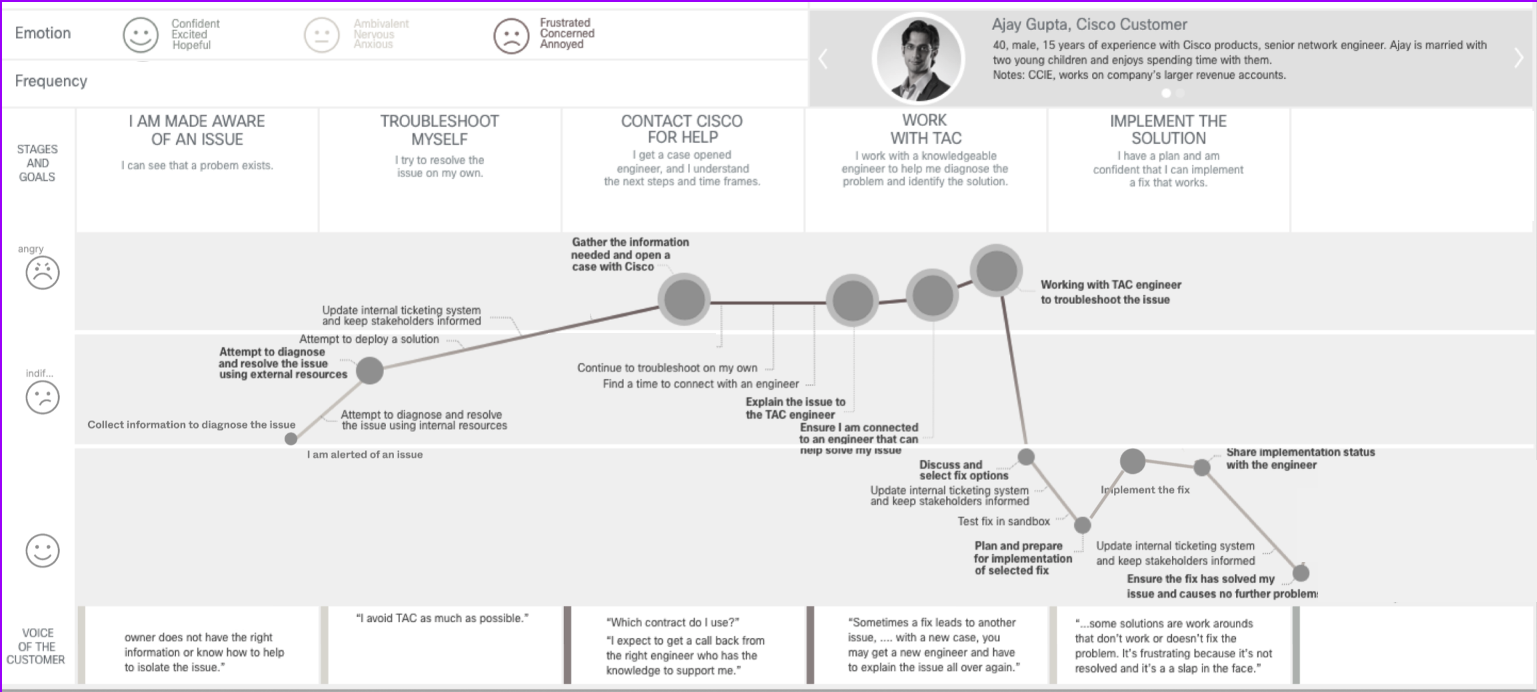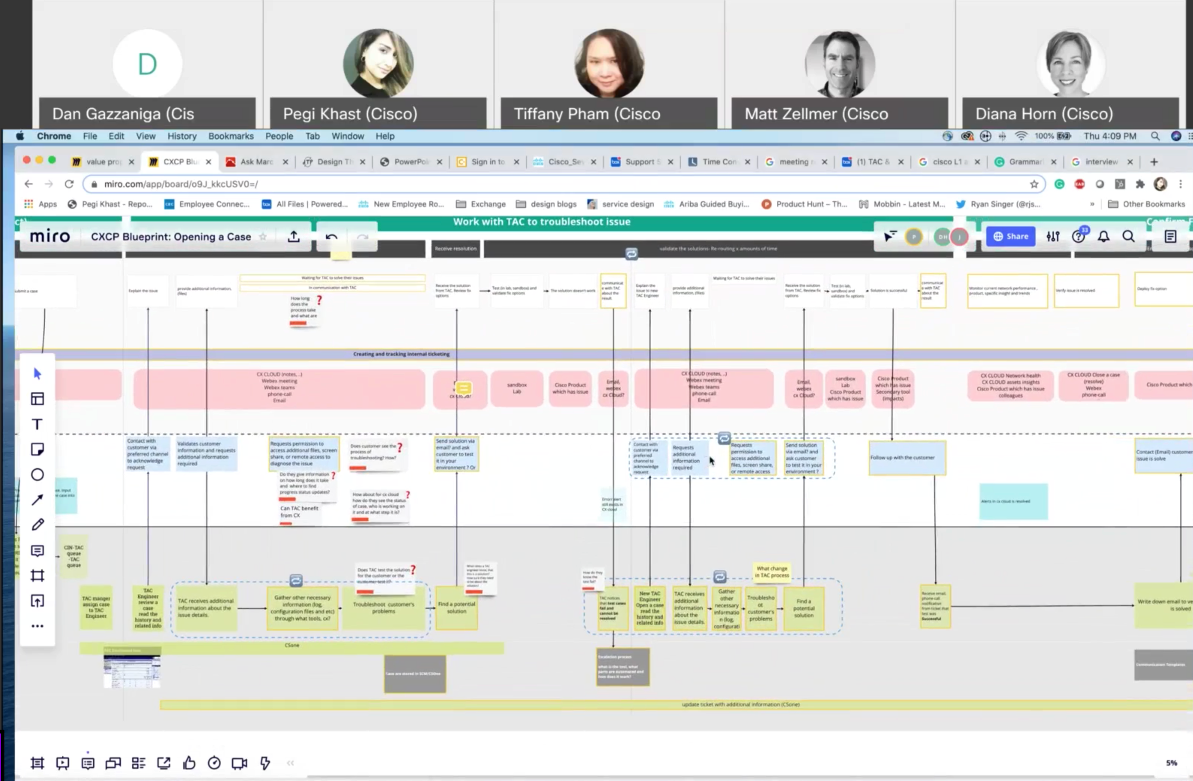Cisco Support Service
Role: Lead ServiceDesigner | Client: Cisco | Time: November 2020- March 2021 | Demo: SB prototype
Cisco is a global technology leader with more than 1000 products in IoT, Cloud, Networking, Collaboration, and Security. Annually $ 20 Billion of Cisco’s revenue are from Support Services. Support case management is a service that allows Cisco’s customers and partners to open a support case. Support case management is a complex service with multiple touchpoints. The goal of this project was to simplify the current experience and create a seamless service experience for customers, partners, and support agents.
I used the service design approach, defined and analyzed the current-state service experience. Propose short-term, and long-term solutions to improve the experience for all the involved parties.
Holistic view of the Support Case Manager
Key Achievements
This project illustrated the end-end experience. It was the first time that cross-functional stakeholders were collaborate together, innovate and come up with solutions to improve the service experience.
Through this project and the series of Lunch and Learn, I was able to educate our design team about the service design and its value for our organization. I received a reward and recognition for this project and the design director asked me to lead 2 new service design projects for Cisco. This was an ongoing project, we estimated that the number of cases will decrease by 10% and the CSAT score will improve significantly.
My Role
I was a lead service designer for this project. I introduced the service design discipline, approach and methods such as Service blueprint. I collaborated closely with Project Managers, Design Directors, UX Designers and the support team. My main tasks were:
Planned and defined the timeline, effort and scope of the project
Conducted qualitative research and led co-creation workshops
Synthesized the findings and create insights and artifacts
Visualized the tangible and intangible aspects of the service
Examined the current-state service experience
Defined short-term and long-term solutions
Validated the solutions with the cross-functional team
Applied what was discovered to align teams and improve the service
The Design Process
Service design thinking process (Stickdorn et al., 2010)
Phase 1: Exploration
Plan and Define: I conducted stakeholder interviews and collaborated with project managers to define the challenge, goals and scope of the project. Main questions I asked:
What problem are we trying to solve
Who are the target groups
What does a successful outcome look like and how to measure it
Who are stakeholders and subject matter experts
What are the service goals
What are the main critical use cases
What is the timeline
Next, I created a research plan and conducted in-depth interviews and walkthroughs with 10 frontline staff and 4 customers. The main goal was to gain deep insights into the current service situation. During this step, I wanted to figure out:
Frequent path, critical path for both customers and internal staff
Steps that customers and frontline staff have to take to achieve their goal
Evidence- tangible and intangible elements- that customers interact with the service
Tools that both customers and frontline staff might use to complete each step
Mistakes, challenges, and pain points during the process
Timeline for each step
In-depth interview and walkme through with support agent
Phase 2: Creation
Synthesizing: I colored code data from interviews, observations and existing research. I used affinity diagram to cluster data, discover the current journey, create key themes and define pain points and opportunities. One artifact of the research phase was an experience map.
Based on the research data I created a Customer’s Experience Map
1st Co-design Workshop: I planned and held a series of co-design workshops with stakeholders. The goal was to define the current-state experience of the Cisco support case manager and analyze the experience: identify critical moments, breakdowns, pain points, timelines, and KPIs for each phase.
Map out the current-experience (front - stage, back -stage and behind the scence)
2nd co-design workshop to analyze the current-state
Phase 3 and 4: Reflection & Implementation
After defining the current challenges, we held a series of meeting with multiple teams across cisco. I demonstrated and validated the current situation, problems and opportunities for each step of the journey. In those meetings, different teams shared ideas and solutions to tackle customers and support team pain points. I identified two types of solutions:
Quick solutions: solutions that need less effort to implement or already existing ones that we were not aware of because of silos. I created a low-fidelity prototype for each quick solution and delivered it to the Lead UX Designer for further development.
Strategic solutions: solutions that do not exist and would take a considerable effort to implement them. Strategic solutions were added to the project pipeline.
Prototype of a quick solution that I delivered it to the Lead UX designer for further development
Results and Takeaways
This project helped our team to design a new service experience for the support case management. It gave a comprehensive understanding of the current service and the underlying resources and processes. Our team was able to view the invisible elements and it helped us to remove all unnecessary processes and design more efficient processes. Also, it improved the collaboration and communication between different teams. This was an ongoing project, we estimated that the number of cases will decrease by 10% and the CSAT score will improve significantly. Some of the key takeaways from this project are:
Starting Service Design projects is challenging. Cisco is a product-focused company, the service design was a completely new discipline for them. When I joined Cisco, It was obvious that they could benefit from the service deign approach tremendously. But it was a challenging process to prove the value to them.
I started by educating our design team, I gave a demo about the basics of service design and why they should care: in that demo, I brought real examples of the current projects and highlighted how service can help to achieve a more successful outcome.
Be patient and earn their trust. It is important that you learn about your audience (stakeholders) and talk with their language and identify low-fruit opportunities that could get them buy-in.
Click here to Figma prototype: SB prototype







